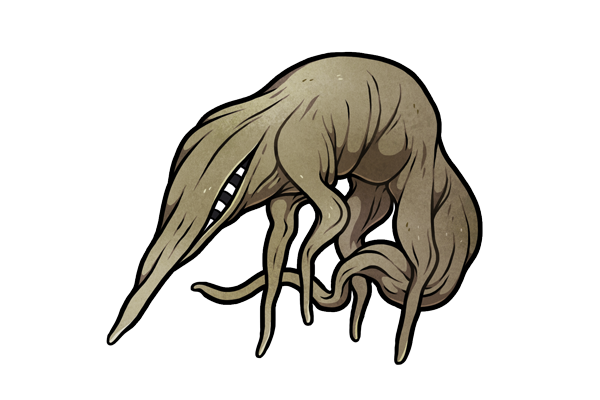

vizidrine
the intruders
prefix vizi suffix drine
physical appearance
The vizidrine /ˈvɪzɪdriːn/ is a small stranger with a body composed of layers of crumpled, kraft paper-like sheets. It lacks musculature, though it can be unfolded to reveal chunks of foul-smelling, slowly-beating grey organs, which grow blotchy and infected when exposed to air. Its limbs lack hands or feet, and are much denser than the vizidrine's otherwise delicate body, as though coated with a hard protectant, allowing these appendages to hold a rigid form. Its eyes appear as white and black strips, which peer out from the folds of its skin. A minority of vizidrine (24-27% within a city), known as "claric vizidrine", are able to create additional, holographic eye markings that drift in the air a fingers-width from the surface of its face. All of a claric vizidrine's eyes are capable of blinking or closing (a function not possessed by non-claric vizidrine). Excepting the pungent odors its organs secrete when exposed, the vizidrine's body is dry and odorless.
The vizidrine's papery form is easily damaged. As its organs merely rest within its folds, and are not encompassed by flesh, even a weak sensitive can tear into the vizidrine's folds and pull out its vital entrails. The strain does possess an above-average regenerative ability, however, and with a shuddering twist of its head, grows new sheets of skin to replace any lost, damaged, or badly dirtied segments. These new sheets grow around the organs, with sullied sheets sloughing off with a shake.
The vizidrine speaks with a low-pitched, whispering buzz, and at a rate much faster than a human being (sounding similar to a voice sped up via a tape recorder, and with no distortion in pitch). Although the stranger does not speak at a loud volume, its voice carries extremely well (with the most healthy individuals being audible at distances of up to four hundred feet, and the direction of its voice cannot be sourced. Thus, the vizidrine is most often heard long before it can be seen. A sensitive in the fifth floor of an apartment building, for example, would be able to clearly hear a basement-dwelling vizidrine as if it was in the same room. The vizidrine's cry does not seem to come from any particular direction, and thus sensitives face some difficulty locating the stranger based on sound alone.
Two percent of infested cities produce utterly silent vizidrine. Even the crinkling paper of their bodies remains mute.
Xixivirv trivixi tititix-vi. Vixivivixivivix.

environment and generation
The vizidrine appears in a wide range of interior and exterior locations, including streets, garages, warehouses, underpasses, tunnels, and parking lots. It is predominantly nocturnal, and prefers dim colors, red or orange-tinted lights, and above all else, layers of grime and heaps of trash.
When it spawns, it appears from thin air, its paper blooming outward layer-by-layer to form the vizidrine's body. It takes less than twenty seconds for a vizidrine to reach maturity. Following generation, the holographic eyes of a claric vizidrine will open and close in a rapid sequence, before the markings settle into their usual slow drift; otherwise, the vizidrine does not wait to begin its life.
Groups of vizidrine appear in close proximity to one another, and stick together. The appearance of large groups also tends to create a small percentage of stillborn individuals, which collapse as rapidly as they bloom, leaving their organs exposed and their skin laying in a crumpled pile. The remaining members of a group will always use their hard limb-tips to deface these piles with indignity, until leaving all organs burst upon the ground.
behaviour
The vizidrine's disposition is inquisitive, yet spiteful. It sneaks through its environment with circumspect steps, its head twining towards whatever catches its interest. A non-claric individual walks with the sound of crumpling leaves, the tips of its attenuated limbs leaving round indentations in dirt, dust, or carpet. As the vizidrine travels, it inspects its surroundings in an investigative, yet lackluster manner, using its handless appendages to push and nudge objects as best it can – pulling open books, turning over cans and bottles, and prodding at piles of tangled string. It tends to direct its focus on objects last touched by humans which are no longer alive, maintaining intent attention on those items last touched by deceased persons whose bodies have not yet been discovered by other humans. It avoids water, but is otherwise fearless towards hazards, its paths remaining undeterred even by fire, which proves expectantly lethal to the stranger's papery form.
Groups of vizidrine travel together and speak in rushed conversations, while loners tend not to speak. When the vizidrine is confronted with another stranger (including other vizidrine sub-strains), it uses its papery form to camouflage itself among the crumpled newsprint and discarded wrappers that fill the spaces in which it dwells, emerging only when alone once more.
there's still space for something new
you can get it back again
are you in a daze?

ϸ
ɟ
ɟ
interactions with sensitives, animals, and corpses
The vizidrine adopts a scrutinizing demeanor towards sensitives. Although it watches indefinitely from a distance, it steps backwards when approached, and shies away from sudden movements.
Despite the vizidrine's weak body and small size, however, it cannot be thought of as harmless. With a quivering of its head and limbs, the vizidrine is able to murder sensitives from afar, its attack accompanied by a high-pitched hum. The victim's skin splits and separates from their body, and their internal organs shrivel up to 60-16% of their original size. This process takes just slightly over a second, the gruesome bloom reminiscent of a flower first expanding, then losing its petals.
The vizidrine's attack leaves behind only a distorted pile of skin and leathery flesh, with the blackened and crumpled skeleton in the center being the only indicator that this had once been a human form. Although from a distance it uses this effect only unpredictably, there is no way for a sensitive to prevent their death once the fickle vizidrine's whims change. In addition, no vizidrine allows a sensitive to get within seven feet of itself. While the stranger can theoretically be destroyed from a distance, their aggressive effect makes them effectively invulnerable to direct harm by sensitives.
The vizidrine displays this same blossoming behaviour towards all animals it encounters, leaving behind small piles of unfolded rats, birds, and insects as it makes its way through a space.
Both human and animal corpses draw the vizidrine's ire, although it is unable to affect them beyond a vague wrinkling and darkening of the flesh. The vizidrine is similarly impotent towards inanimate objects, aside from a shaking of certain paper bags, or a rolling of empty cans.
aging and death
As the vizidrine ages, its body becomes stained and ragged, and it grows more suspicious in its demeanor, and, therefore, more likely to aggress both sensitives and animals. The passage of time, however, weakens the vizidrine's effect, leading to partial unfurling of limbs, garish splitting of flesh, or peeling of skin with no damage to the muscles underneath. Eventually, its effect begins to extend to other vizidrine, as well, with either full or partial success. Once this occurs, the remaining individuals violently expel the offender from the group.
A vizidrine at the end of its life continues its roam, even as it begins to rot from the inside out. Its organs wrinkle and grow pale, its gait becomes shaky, and its skin moistens outwards layer-by-layer. Once the vizidrine can no longer support its own form, it collapses into a moldy, blackened pile.
A fallen vizidrine's body peels apart in dark and brittle sheets, its organs hissing and sizzling away as the air touches them. Any surviving companions take brief interest in this corpse (sometimes using their own effects to open these sheets and organs up further), each member of the group prodding the wrinkled folds with their slender limbs, before they return to their own sneaking wanders.



